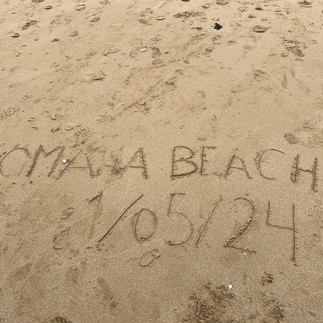D-Day - 80th Anniversary
- Terri Tomoff
- Jun 6, 2024
- 4 min read
There is something to be said about my being fortunate to visit Normandy two years in a row, including this past May Day, or May 1, while in Paris, France, before the writer’s retreat in the South and later in the month. But first, Paris and its environs.
When I visited the area of Normandy (Colleville-Sur-Mer) last year with Hubby Bill and our son, Ryan, we took an extended tour (meeting up at the Eiffel Tower at 7:00 am sharp for an almost 14-hour day) that was on a big bus, 30+ people and our guide.
It was wonderful. Our guide was versed in so many stories that brought the history to life - even as triumphant and sad it all was when over 9000 US soldiers were killed 80 years ago (79 years ago last year in the good fight).
In fact, after starting our trip in London and dropping down to Paris after a few days (taking the Chunnel), Ryan was delighted with all of it. When he flew home before Bill and me and was picked up by a friend of mine, Deb, she asked him the quintessential question about his favorite memory of the trip. He didn’t hesitate to shout out from the back seat, “Normandy!” I think Deb was taken aback by his answer initially, but he backed it up (according to her) by mentioning how profound and poignant the visit really was, and more people need to see and feel that area of France, including the beaches and cemetery.
If our troops had not taken that area over, I don’t believe we would have the freedoms we enjoy all these years later, much to the sacrifice of our men and women in uniform in very difficult circumstances in 1944 and until the end of the war in April of 1945 (but there was still fighting beyond the dropping of the Atomic bombs).
Fast forward to this May when my friend Linda Misencik and I boarded a smaller bus (about 15 people - again, the meet-up near the Eiffel Tower) and were whisked back to the region of Normandy. Once again, I felt great sadness about that fateful day when US soldiers and Army Ranger Units sustained heavy losses, but I am grateful for them and their ultimate sacrifice for the rest of the world to live in freedom and peace (peace is the ultimate hope!). Of course, it cost the entire world the loss of too many lives throughout WW11 and beyond, and not only soldiers from many countries in the good fight - but all those innocent lives in Europe and beyond.
Are you curious about how many boats crossed the Channel? If so, the beaches were given the code names UTAH, OMAHA (suffered the most casualties - 2500 men on D-Day, GOLD, JUNO, and SWORD. The invasion force included 7,000 ships and landing craft manned by over 195,000 naval personnel from eight allied countries. In addition to the above fact, more than 5,000 were wounded on D-Day. In the ensuing Battle of Normandy, 73,000 Allied forces were killed and 153,000 wounded. Sadly, the Allied bombings of French villages and cities killed around 20,000 French civilians.
So, when in Normandy, it doesn’t take long to look around and realize the entire area is sacred ground. Every spec of sand and blade of grass. As you glance into the distance, you can just feel the largest amphibious landing force ever assembled begin moving through the storm-tossed waters toward the beaches. Most of the Americans were packed into flat-bottomed Higgins boats launched from troop transports 10 miles from the French coastline (as the photo below depicts).
The place is that powerful.
For the second time, I hung my head and prayed for those brave souls who were young and scared out of their wits to jump from the ships into the frigid waters of the English Chanel to run up and defeat the Nazis who were shooting at them from the cliff bunkers all day long.
According to the placard at the Normandy American Cemetery, Any Americans killed in Normandy were buried in temporary cemeteries during the campaign. After the war, families were given the choice to leave their loved ones in Normandy or bring them home for burial. The permanent cemetery was completed in 1956. The cemetery site covers 175 acres and contains the graves of over 9000 military dead. Roughly 1000 lost their lives in the D-Day landings and the rest in the ensuring operations of the Normandy Campaign.
In a few years, most of the men—the witnesses— who served our nation and the rest of the world will be gone. My hope is that there are stories that will be handed down by the brave soldiers to their families. I know it was difficult to recall or even talk about the events (timeline) that day from the survivors, but I’m sure there are a few who took pen to paper to draft their memories with courage and intentions.
Frankly, it’s those personal stories that resonate with me the most. Not a Hollywood movie (except The Longest Day with John Wayne), but the grit, grace, and maybe humorous and scary moments that could enchant/educate/enlighten millions of people someday about the ugliness of war and the devastation it brings to so many.
Writing with Gratitude,
Terri


















Comments